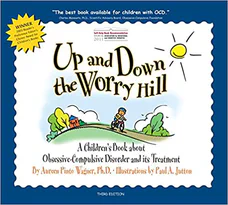Up and Down the Worry Hill
A Children’s Book about Obsessive-Compulsive Disorder and Its Treatment
Written by Aureen Pinto Wagner, Ph.D.
Illustrated by Paul A. Jutton
48 pages
•
Published Original publication in 2000; 3rd edition in 2013 (Lighthouse Press)

Recommended Age Range: Best for 1st through 5th grade. It’s a bit long and wordy for younger kids.

Dr. Annie's Takeaways
Recommended for: A child who has recently been diagnosed with OCD and/or who is exhibiting OCD symptoms and is about to start treatment with a therapist trained in Exposure and Response Prevention (ERP)
. A therapist could read it with a child in an early therapy session, or parents could read it with their child prior to starting therapy.
Would a child like it? A child who is confused, scared, and/or otherwise negatively impacted by their OCD would appreciate this book’s straightforward approach and promise of a future freer of OCD. It’s not a particularly engaging book, but it’s a useful book.
Tone: Reassuring
Story Quality: The story itself is a little blah. A child is experiencing many symptoms of OCD (seemingly intended to cover all of the most common symptoms that kids experience rather than showing an authentic depiction of OCD). His parents take him to see a child psychologist who teaches him how to conquer his OCD. A metaphor of riding a bike up a hill and then coasting down is used to motivate the effort it takes to fight back against OCD and the feeling of freedom that can result. There are a lot of words, and I think in an effort to be accurate and inclusive, too much detail is included. The book ultimately feels like a mediocre vessel for psychoeducation
rather than a particularly compelling story. But it’s a decent introduction to Exposure and Response Prevention (ERP)
, the gold-standard treatment for OCD.
Illustrations: Simple black and white line drawings that look a bit like coloring pages
Representation: The main character, Casey, is a White boy with a sister, mother, and father. They live in a suburban-appearing home, and Casey and his dad ride bikes together.
Psychological Practices: This book includes symptoms of many different presentations of OCD, including “not just right” feelings and compulsions (e.g., counting stairs, eating in a certain order), intrusive thoughts (i.e., “bad thoughts”), germ obsessions and handwashing, reassurance seeking, and perfectionism and compulsive erasing/ redoing. It is unusual for one child to have all of these symptoms, but seeing them described could help parents and kids to identify behaviors that they didn’t realize were OCD. It also introduces therapy and Exposure and Response Prevention (ERP)
–the gold standard treatment for OCD–in a fairly effective way (the book uses the name Exposure and Ritual Prevention, which is less commonly used than Exposure and Response Prevention). I appreciated the reminder that everyone falls off of their bike now and then and, likewise, there will be OCD slip-ups. This book includes a notable mention that medication
helps some kids to manage their OCD–this normalizes medication use for children and their parents, which is important because medication is often an important tool in OCD treatment.
Concerns: None
